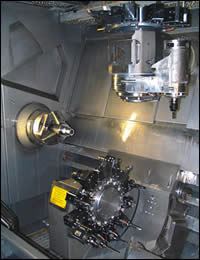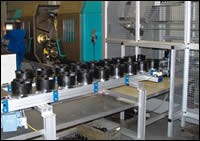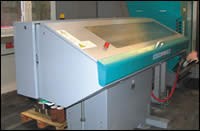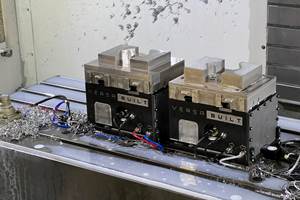Double-Sided Productivity
Having a bar feeder on one side and a parts carrousel on the other side ensures that a turn-mill machine will achieve maximum productivity, whether the workpieces are mostly milled or mostly turned. In general, smaller parts are machined from bar stock, even if only milling operations are involved. Larger parts are loaded an unloaded by a transfer device fed by the carrousel.
Share




Adding an automatic bar feeder to a CNC turning center is one way to boost productivity and free up an operator. On a milling machine, loading and unloading workpieces with an automated part transfer device fed by a carrousel can have the same benefits. So it stands to reason that a shop with a turn-mill machine might consider both options. This means equipping it with a bar feeder and a parts carrousel.
That’s exactly what EWS Weigele GmbH & Co. did with its G250 turn-mill machine from Index Corp. (Germany and Noblesville, Indiana). EWS manufactures static and driven tools for lathes and turn-mill machines (distributed in the United States by ITI Tooling, Ramsey, New Jersey). The company’s main factory is in Uhingen, Germany, not far from Esslingen, the city that is home to Index’s corporate offices and one of its production facilities. Being neighbors in the region around Stuttgart in southwest Germany is not the only connection between EWS and this machine tool builder.
Many of EWS’s tooling products are designed for the multi-spindle lathes and turn-mill machines built by Index. In fact, the shop’s turn-mill machine with the bar feeder and carrousel not only produces parts for these tooling systems, but the machine uses one as well. The shop uses the EWS Varia to reduce setup time and to enhance the speed and flexibility of the machine’s double-turret, double-spindle configuration.
This unusual, almost symbiotic, relationship makes the turn-mill interesting on several levels at once. You can see how two very different workpiece delivery systems make sense for this type of machine. You can see how the variety of parts produced for the tooling system calls for the flexibility of the machine’s combined turning and milling capability. You can see how the quick-change features of the Varia system and the modular nature of its tooling elements benefit part processing on a turn-mill machine.
EWS acquired the G250 in 2005 in response to growing demand for live tooling units as multitasking machine tools become more popular around the world. Flexibility and short setup times are critical. The company has a wide range of products and wants to adhere to lean manufacturing principles that allow it to fill orders from stock yet keep work in progress low. Likewise, the accuracy of the new machine was important. Many of the components it machines require close tolerances because the tooling units assembled from them are high-precision products with guaranteed concentricity and repeatability.
Configured For Efficiency
EWS was founded in 1960 by Ernst Weigele and his sons, Gerhard and Karl, as a job shop that specialized in hydraulic components. In 1971, the shop acquired its first NC lathe, but it had to produce its own toolholders,because none were commercially available in those early days of NC turning technology. Soon, the company was manufacturing these toolholders for other shops, and it made this work its main occupation. By 1982, the company was selling its tooling products on a worldwide basis. In 1991, it began producing driven tools. In 1995, Frank and Matthias Weigele joined the management team, bringing the third generation into leadership positions. Along the way, the company relocated several times to accommodate its growth, finally moving into its current location in Uhingen in 2000.
The EWS Varia system, introduced in 2003, is the company’s most innovative development to date. This modular system for static and driven tooling leaves the toolholder body in the tool station as a fixture while swapping toolheads in and out separately. Thus, a tool station can be retooled in about 15 seconds, according to Matthias Weigele.
Once released and removed from the fixtured tool body, a toolhead can be attended to away from the machine. This may involve indexing a carbide insert to expose a fresh cutting edge, replacing a worn end mill or twist drill or completely rebuilding the toolhead with a different style of collet and cutting tool as needed. The renewed toolhead can be returned in a preset condition. When reinstalled in the tool station, the toolhead requires a single clamping point and does not need to be realigned.
As Mr. Weigele points out, the effectiveness of this approach to quick-change tooling depends on the precision and sturdiness of all elements in the system. To make the system practical and affordable, the company’s manufacturing process has to be highly efficient, capable and flexible. These requirements explain why EWS looked to a multitasking machine such as the turn-mill center to bolster the production resources needed to meet its goals.
The turn-mill center appealed to EWS because its modular construction allowed the company to configure it most appropriately for the type and variety of the parts it was expected to produce, Mr. Weigele says. For example, machining these parts generally requires many different tools and short cycle times. As Mr. Weigele explains, “Our turn-mill center has an upper and lower turret, each with 12 tool stations that can be doubled up with two tooling units. We try to do as many operations as possible with tools on the turrets because tool-change times are much faster with the turrets than with the automatic toolchanger that serves the milling spindle.” The turrets take 1 to 2 seconds for a tool change, whereas the automatic tool changer takes 12 seconds.
Of course, the milling spindle is available for heavy milling operations such as machining flats on tool holder bodies and other parts.
Another reason why making full use of the turrets recommends itself is that the turrets take advantage of the Varia quick-change tooling system. “With the tooling stations on the turrets fully utilized, it is important that we minimize downtime to renew or change-over the high number of cutting tools involved,” Mr. Weigele says.
Bar Feeder Vs. Carrousel
A similar strategy applies to part loading options. Just as EWS’s part processing seeks to fully exploit the use of the tool turrets, it seeks to exploit the bar feeder as much as possible. Whether a part is mostly turned or mostly milled, if it has a cross section less than 90 mm (about 3.5 inches), it will be produced from round or hex-shaped bar stock whenever possible.
Because the turn-mill center combines turning and milling capability on one platform, parts can frequently be produced in one pass through the machine. A bar-fed part completed in the main turning spindle can be grasped by the subspindle before a cutoff operation. Separated from the bar stock, the freed part in the subspindle can receive final end working operations. Thus, a prismatic part can be fully machined on all six sides. It is possible to machine parts in each spindle simultaneously, another reason why the turn-mill concept is so productive. Regardless of how the part is processed, the transfer device can retrieve a finished part from the subspindle and place it on the carrousel. There it will wait to be unloaded when the operator returns.
Mr. Weigele estimates that 80 percent of the parts produced on the turn-mill center enter the machine as bar stock. However, he considers the availability of the carrousel for handling workpieces too large to be cut from bar to be a major asset. Typically, these parts involve relatively long cycle times, so this approach lends itself especially well to lightly attended operation during an overnight or weekend shift. “The carrousel can be loaded with blank workpieces at the end of a shift, and in the morning, all of the parts in the carrousel will be finished,” Mr. Weigele says.
Workpieces that are loaded from the carrousel can be as large as 200 mm indiameter and as long as 400 mm. That means the turn-mill has a considerable range of part sizes that it can process. A key factor in this flexibility is the extended stroke of the milling spindle in the Y axis. The milling spindle can move as much as 100 mm in each direction from the centerline of the main turning spindle.
According to Mr. Weigele, no other turn-mill machine can offer this capability. For him, it represents one of the most economical aspects of taking this approach to flexible part production. He sees the turn-mill center as more than a single machine that can do the work of two. It’s more like a cell of multiple standalone lathes and mills. This makes the investment in this technology very worthwhile.
Finally, it is very gratifying to him that his company’s own Varia tooling system is a key part of this productivity package. That this quick-change system helps unlock the potential of the turn-mill concept in general and of this configurable machine in particular is a validation of EWS’s efforts to move tooling technology forward.
Related Content
Prioritizing Workholding Density Versus Simplicity
Determining whether to use high-density fixtures or to simplify workholding requires a deeper look into the details of your parts and processes.
Read MoreUsing Jaws as Grippers Enables Flexible, Low-Cost Automation
VersaBuilt’s automation systems significantly boosted Innovative Fabrication’s revenue. In return, the shop has helped VersaBuilt optimize its products.
Read MoreCustom Workholding Principles to Live By
Workholding solutions can take on infinite forms and all would be correct to some degree. Follow these tips to help optimize custom workholding solutions.
Read MoreChuck Jaws Achieve 77% Weight Reduction Through 3D Printing
Alpha Precision Group (APG) has developed an innovative workholding design for faster spindle speeds through sinter-based additive manufacturing.
Read MoreRead Next
5 Rules of Thumb for Buying CNC Machine Tools
Use these tips to carefully plan your machine tool purchases and to avoid regretting your decision later.
Read MoreBuilding Out a Foundation for Student Machinists
Autodesk and Haas have teamed up to produce an introductory course for students that covers the basics of CAD, CAM and CNC while providing them with a portfolio part.
Read MoreRegistration Now Open for the Precision Machining Technology Show (PMTS) 2025
The precision machining industry’s premier event returns to Cleveland, OH, April 1-3.
Read More


































